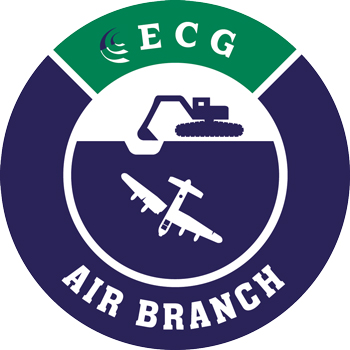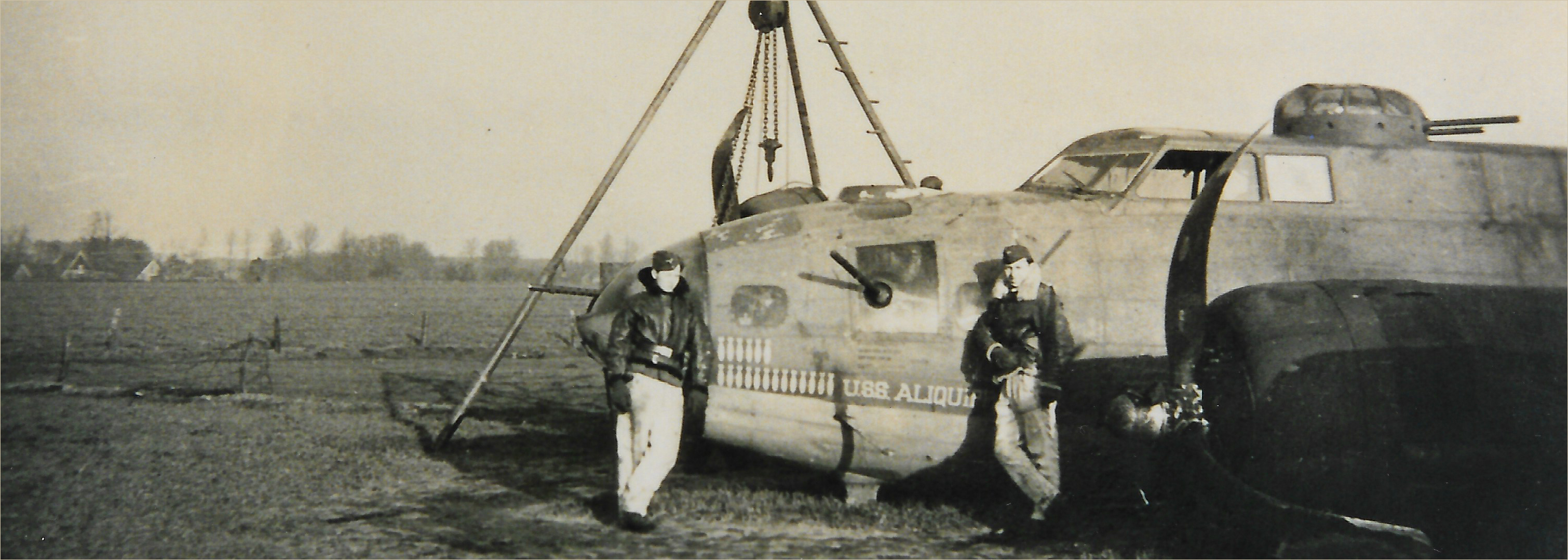Air Branch
"The Redemption of a Debt of Honour."
During the Second World War, almost 6,000  Aircraft came down. These planes crashed into the ground, but also into the sea, lake and river bed. The aircraft were from the warring factions of the RAF (Royal Air Force), the USAAF (United States Army Air Force) or the German Luftwaffe. Many made an emergency landing and were easily cleared at the time. Others drilled themselves sometimes metres deep into the Dutch soil. By now, hundreds of these wrecks or their remains have been cleared, but it is estimated that at least 2,000 wrecks are still in Dutch territory.
Aircraft came down. These planes crashed into the ground, but also into the sea, lake and river bed. The aircraft were from the warring factions of the RAF (Royal Air Force), the USAAF (United States Army Air Force) or the German Luftwaffe. Many made an emergency landing and were easily cleared at the time. Others drilled themselves sometimes metres deep into the Dutch soil. By now, hundreds of these wrecks or their remains have been cleared, but it is estimated that at least 2,000 wrecks are still in Dutch territory.
Specific investigation advice through multidisciplinary approach
In approximately 400 of these aircraft wrecks, the mortal remains of the killed occupants can still be found to this day. In the meantime, a list has been compiled by SGLO (Studiegroep Luchtoorlog 1939-1945) with 30 to 50 cases of which at least the location is known and where there is a suspicion that there are still missing persons.
As ECG Air Branch, we would like to contribute to the repayment of the Dutch debt of honour: finding the missing. By calling in ECG Air Branch for your aircraft salvage, you get all the necessary expertise at once, whereby the result counts for us! ECG Air Branch can relieve you of the entire salvage process, including:
- Historical background research
- Detection of Explosive Remnants of War (OOO) and detection of ground disturbances
- Environmental and soil testing for harmful substances
- Civil engineering support for the project
- Asbestos inventory and soil remediation supervision
- If required, archaeological support and, of course, the
- Groundwork
Of course, we do this with only certified and skilled personnel in cooperation with the responsible municipality, the Staff Officer Aircraft Salvage (SOVB), the Explosives Ordnance Disposal (EOD) and finally with the Salvage and Identification Service of the Royal Netherlands Army (BIDKL).







Frequently asked questions
The reason for salvaging can be many. First of all, a wreck may be in the way of a (future) construction project or it may lie in a planned cable or pipeline route. It can also be for reasons of safety: an aircraft wreck is often full of explosive remnants of war, such as aircraft bombs, ammunition from the weapons (artillery and cartridges), pyrotechnical ammunition such as signal cartridges and other aircraft-related explosives. An aircraft wreck almost always involves environmental aspects: thousands of litres of leaded aviation gasoline, hundreds of litres of oil, hydraulic oils and aromatics, tightly bound asbestos.
Another important reason may be: piety. Most aircraft wrecks contain the mortal remains of the crew members. These must be removed with great care and handed over to the competent authorities (BIDKL). In some 400 aircraft wrecks, there is even talk of missing crew members. The Ministry of the Interior and Kingdom Relations has set up a 'National Programme for the Recovery of Aircraft Wrecks' especially for this purpose. A working group also formed by the Ministry of the Interior is looking into which aircraft qualify for salvaging. The municipalities concerned will automatically be informed by the working group.
A municipality is eligible for full compensation, provided that the aircraft wreck concerned is part of the 'National Programme for the Salvage of Wrecked Aircraft with Still Missing Flying Members from the Second World War'. The Ministry of the Interior and Kingdom Relations has set up a working group that is to determine which aircraft have a 'good chance' of being successfully recovered. Only if this is the case will the municipalities in question receive a letter of notification from this working group.
In such a situation, the mortal remains of missing pilots must still be in the wreckage. If the crew is buried under their own name, the salvage operation falls under the Bomb Regulations with a compensation percentage of 68%.
The SGLO (study group Air War 1939-1945) compiled a list of 400 cases of plane wrecks still containing the mortal remains of missing crew members. That list has been reduced to approximately 60 crashes. BZK has acknowledged the necessity of actively tracing and salvaging these missing people: the Netherlands hopes to fulfil its debt of honour with this. Therefore, a working group has been formed by the same Ministry of the Interior and Kingdom Relations that will look at the salvages from the list of 60 that are actually considered successful, i.e. 'promising'. These will be approximately 40 specific cases. The municipalities concerned will be 'relieved' of their responsibilities and will receive a letter from the aforementioned working group and will also be informed by the SOVB (Staff Officer Aircraft Salvage).
You can read all about it in the Circular on Aircraft Salvage dated 19 October 2016, 54987 of the government and additionally in the letter from the Minister of the Interior drs. K.H. Ollongren, dated 16 October 2018, reference 2018-0000820816.
Adhered asbestos from e.g. brake linings, radioactive material (Radium 226) from e.g. aircraft instruments, leaded aviation gasoline, motor oils, hydraulic oils and explosive substances (these substances are chemical and toxic).
Aircraft bombs (projectile ammunition) and submunitions (cluster munitions such as small bomblets or incendiary bombs), target marking devices, KKM with the specific feature of small 13 and 15 mm shells from the German in-flight machine guns, 2cm and 3cm shells, pyrotechnic ammunition and incendiary devices such as signal cartridges, handflame cartridges, smoke agents, KKM from personal armament, but also, for example, aircraft-specific explosive components.
Immediately cease operations and submit request for salvage support to Commandant of Woensdrecht Logistics Centre, PO Box 8762, 4820 BB Breda. The latter will inform the SOVB. Furthermore, ECG Air Branch will provide you with appropriate advice and is happy to think along with you in order to relieve you of as much of your worries as possible.
Please contact the Preliminary Investigation Department of ECG. This specialist department, of course in cooperation with ECG Air Branch, can conduct a reliable, historical investigation and in this way determine the location and the size of the risk area. The explosives load of the aircraft and the residual risk can also be checked. A logical next step would then be to have ECG conduct a detection survey at the suspected location. After interpreting the data, we can then see whether or not the soil is free of wreckage. ECG Air Branch will be happy to advise you on the next steps without any obligation on your part.
Please contact the Preliminary Investigation Department of ECG. This specialist department, of course in cooperation with ECG Air Branch, can conduct a reliable, historical investigation and in this way determine the location and the size of the risk area. The explosives load of the aircraft and the residual risk can also be checked. A logical next step would then be to have ECG conduct a detection survey at the suspected location. After interpreting the data, we can then see whether or not the soil is free of wreckage. ECG Air Branch will be happy to advise you on the next steps without any obligation on your part.
The costs of a disposal depend on many factors. Such as the size, depth, location (land or water), the civil-engineering support required for a disposal, etc. Seventy per cent of all the necessary work is reimbursed by the State.
In accordance with the law of war, German aircraft wreckage falls under "spoils of war", while the Allied wreckage officially goes to the country of origin. In practice, the wreckage remains the property of the KLu salvage service, which then gives it on long-term loan to museums or it is used for a local monument.